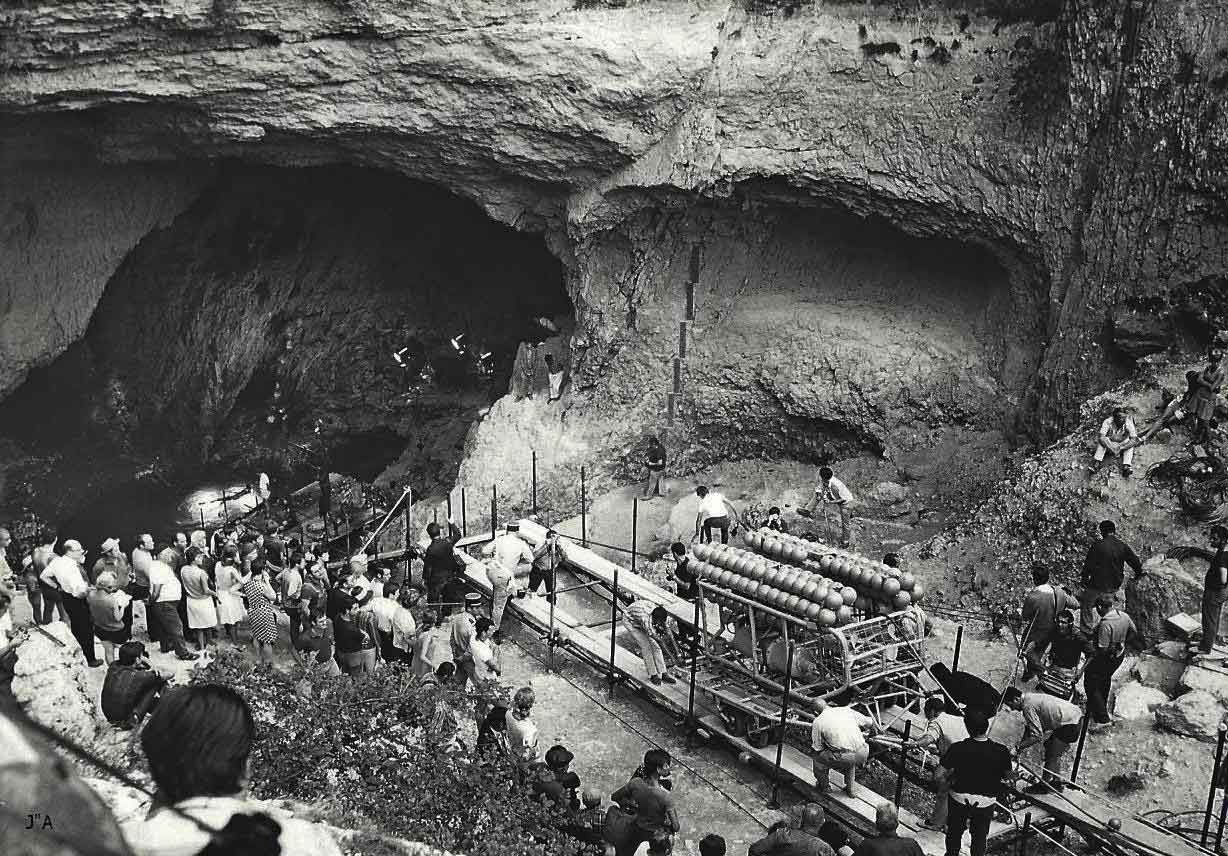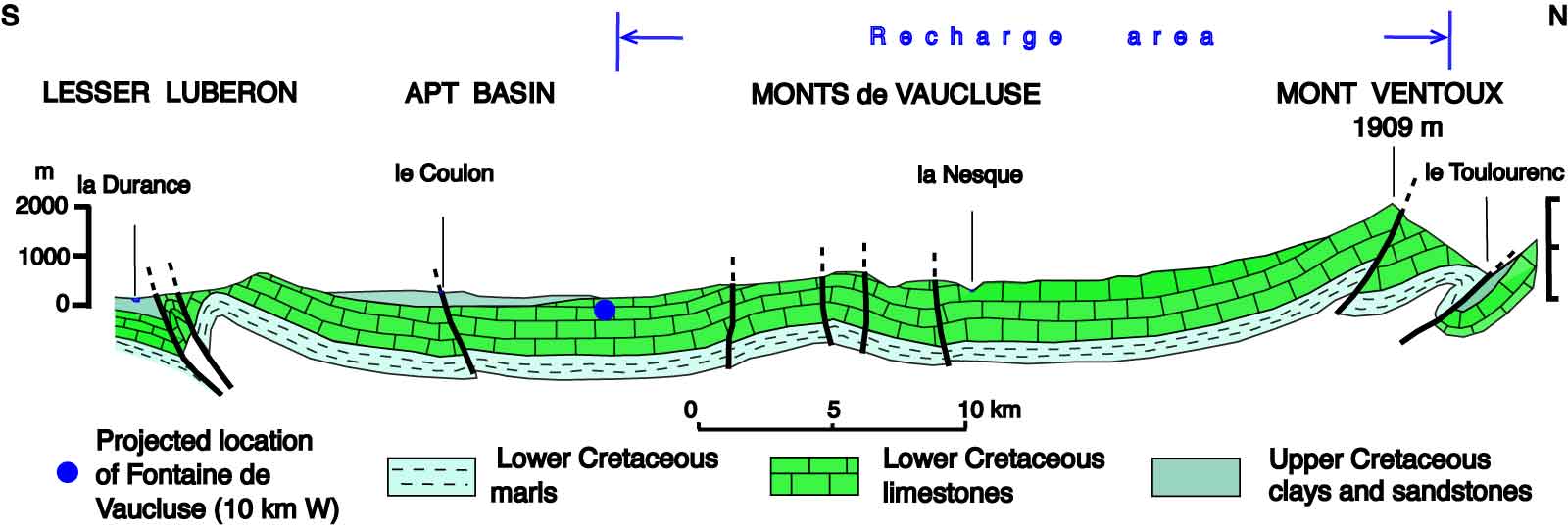
Upper outlet of the Fontaine de Vaucluse during high water period (64.5 m3/s). (Photo by E. Simon).
Geological Period
Miocene to Quaternary
Main geological interest
Geomorphology and active geological processes
History of geosciences
Location
Provence, France
43°55’04”N, 005°07’57”E
Upper outlet of the Fontaine de Vaucluse during high water period (64.5 m3/s). (Photo by E. Simon).
The locus typicus ascending spring with the globally longest history of recorded discharge.
The Fontane de Vaucluse is a part of a large karst system developed during the Messinian Crisis of salinity at the end of Miocene (Audra et al., 2004). It is a lake spring with deep siphonal karst conduits and is considered as locus typicus for all such springs worldwide (the term: “vauclusian type”). The spring discharge has been recorded since 1878, making this spring the best explored in the world in terms of drainage regime. Minimal discharge is 3.1 m3/s, average 17.3 m3/s which is the largest in France, while the maximum exceeds 80 m3/s.
- Geological description
The Fontaine de Vaucluse is one of the most famous and best explored karst springs in the world, located in Provence, about 30 kilometers east of the city of Avignon. The deep siphonal karst conduits, the huge discharges variation and the high minimal discharge values during low flows attracted researchers from all over the world. Blavoux et al. (1992) defined a catchment area of about 1,100 km2 (today up to 1,160 km2). The Lower Cretaceous limestones of Urgonian facies (Barremian-Aptian age) are 1,500 meters thick and highly karstified. The thickness of the unsaturated zone can exceed 800 meters; four chasms on the plateau are more than 500 meters deep (Gaubert and Le Falher, 1990), and one shaft reaches the saturated zone 30 kilometers upstream the spring.
The spring comprises a siphonal pool with an upper outlet which flows only during high water periods and a downstream outlet where groundwater continuously discharges through thick debris zone with huge fallen blocks, giving rise to the Sorgue River, one of the Rhône’s tributaries. Over one hydrological year, the mean water table level fluctuations at the outlet are of about 25 meters (Blavoux et al., 1992; Cognard-Plancq et al., 2006; Bonacci, 2007).
- Scientific research and tradition
The Fontaine de Vaucluse has been surveyed by many speleo divers and underwater vehicles. The Vaucluse’s museum “Le Monde Souterrain” provides information on history of speleodiving surveys starting with the one of Ottonelli (1878), then of famous Commandant Cousteau (1944, 1955),… The deepest exploration at – 308 meters was made by the ROV Modexa (1985).
- Reference
Audra, P. et al. (2004) ‘The effect of the Messinian Deep Stage on karst development around the Mediterranean Sea. Examples from Southern France’, Geodinamica Acta – GEODIN ACTA, 17, pp. 389–400. Available at: https://doi.org/10.3166/ga.17.389-400.
Blavoux, B., Mudry, J. and Puig, J.-M. (1992) ‘The karst system of the Fontaine de Vaucluse (Southeastern France)’, Environmental Geology and Water Sciences, 19(3), pp. 215–225. Available at: https://doi.org/10.1007/BF01704088.
Bonacci, O. (2007) ‘Analysis of Long-Term (1878-2004) Mean Annual Discharges of the Karst Spring Fontaine de Vaucluse (France)’, Acta Carsologica, 36(1). Available at: https://doi.org/10.3986/ac.v36i1.217.
Cognard-Plancq, A.-L., Gévaudan, C. and Emblanch, C. (2006) ‘Historical monthly rainfall-runoff database on Fontaine de Vaucluse karst system: review and lessons’, in Karst, cambio climatico y aguas subterraneas. Geological and Mining Institute of Spain (Hidrogeologia y Aguas Subterrraneas, 18), pp. 465–475.
Gaubert, G. and Le Falher, B. (1990) Les cavernes d’Albion. Hydrologie et spéléologie des territoires alimentant en eau la Fontaine de Vaucluse. Association de recherches et d’études hydrologiques du Plateau d’Albion (AREHPA).
Puig, J.-M. (1987) Le système karstique de la Fontaine de Vaucluse. These de doctorat. Avignon. Available at: https://theses.fr/1987AVIG0004.
- Author(s)
Zoran Stevanovic.
(Past-Chair) The Karst Commission of the International Association of Hydrogeologists, Univ. Belgrade. Servia.
Michel Bakalowicz.
The Karst Commission of the International Association of Hydrogeologists, CNRS, Univ. Montpellier. France.
Hervé Jourde.
The Karst Commission of the International Association of Hydrogeologists, Univ. Montpellier. France.
Jacques Mudry.
The Karst Commission of the International Association of Hydrogeologists, Univ. Besançon. France.
Naomi Mazzilli.
Univ. Avignon. France.
Christophe Emblanch.
Univ. Avignon. France.


